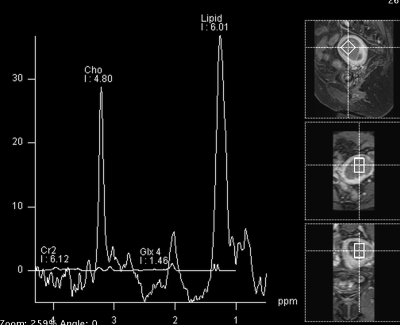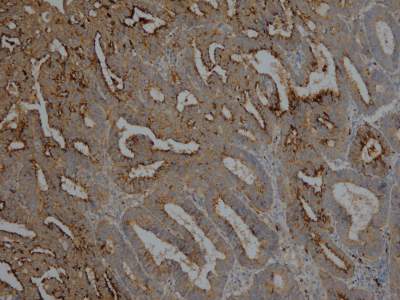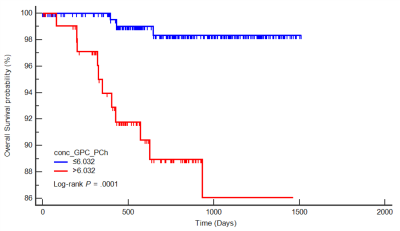0586
Total Choline Level on MRS Predicts Overall Survival for Endometrial Cancer and Correlates with Tissue Choline Metabolism
Gigin Lin1, Shang-Yueh Tsai2, Yu-Chun Lin1, Chiao-Yun Lin1, Ren-Chin Wu1, and Chyong-Huey Lai1
1Chang Gung Memorial Hospital, Linkou, Taiwan, 2National Chengchi University, Taipei, Taiwan
1Chang Gung Memorial Hospital, Linkou, Taiwan, 2National Chengchi University, Taipei, Taiwan
Synopsis
Endometrial cancer is the most common gynecologic cancer in the developed countries but responses differently to the standard treatment. We aim to investigate and characterize the values of endometrial total choline levels on 1H MR spectroscopy in predicting overall survival, with tissue metabolomics and biochemistry corroboration. We found that increased total choline levels on MRS depicted high-risk cancer group for nodal metastasis, overall survival and disease-free survival for endometrial cancers, supported by increased tissue GPC levels and overexpression of EDI3.
INTRODUCTION
Endometrial cancer is the most common gynecologic cancer in the developed countries but responses differently to the standard treatment. We aim to investigate and characterize the values of endometrial total choline levels on 1H MR spectroscopy in predicting overall survival, with tissue metabolomics and biochemistry corroboration.METHODS
1H MRS using external phase array coil was prospectively conducted in 353 consecutive endometrial cancer patients at 3 Tesla (T) to evaluate tumor choline levels in vivo (δ 3.2 ppm), according to their nodal metastasis status (n=10, 11, 236 in stage N2, N1, N0, respectively). Endometrial tumors were further analyzed (n=81) using a 600MHz high-resolution nuclear magnetic resonance (NMR) system to correlate the tissue levels of choline-related metabolites—free choline, phosphocholine (PC) and glycerophosphocholine (GPC). We corroborated the expression of a key enzyme in choline metabolism—endometrial carcinoma differential 3 (EDI3). Statistical methods included Mann-Whitney U test, Kruskal-Wallis H test, logistic regression, Pearson’s correlation, and Kaplan-Meier survival analysis. A P value < 0.05 was considered a significant statistical difference.RESULTS
Total choline levels were significantly higher in endometrial cancers with nodal metastasis (N2: 14.93±6.23mM, N1: 6.20±2.42mM, N0: 6.04±0.60mM, mean ± standard error of mean, P = .039), measured using in vivo MRS. Elevated choline levels on MRS significantly increased the risk of para-aortic lymph node metastasis (odds ratio 1.06; 95% confidence interval 0.99-1.13, P = .046). Using the cut-off value of 6.03 on MRS, significantly stratified risk groups for overall survival (P = .0001) and disease-free survival (P = .0057). Changes of choline on MRS significantly correlated with the tissue levels of GPC (r = 0.322 P = .002), but not PC (P = .588) nor free choline (P = .697). The key enzyme in choline metabolism EDI3 overexpressed in tumors from endometrial cancer with nodal metastasis (P = .040).DISCUSSION
Pelvic MRI is the standard-of-care for women diagnosed with endometrial cancer and provides anatomical information for TNM staging. Recently, MRS is found to be useful for differentiating uterine tumors originating from cervix or endometrium.1,2 Our study supported the previous initial experiences using MRS to correlate with the tumor aggressiveness,3-5 and further validated the prognostic values of MRS in this longitudinal cohort.CONCLUSION
Increased total choline levels on MRS depicted high-risk cancer group for nodal metastasis, overall survival and disease-free survival for endometrial cancers, supported by increased tissue GPC levels and overexpression of EDI3.Acknowledgements
This study was funded by the National Science Council, Taiwan (grant no.: NSC 103-2314-B-182A-006), Ministry of Science and Technology, Taiwan (grant no.: MOST 104-2314-B-182A-095-MY3) and Chang Gung Medical Foundation grant CIRPG3E0022, CPRPG3G0023, CIRPG3H0012.References
- Celik O, Yilmaz E, Boz M et al. Spectroscopy analysis of cervical carcinoma originated from endometrial carcinoma. J Obstet Gynaecol. 2012; 32: 409-410.
- Lin G, Lin YC, Wu RC et al. Developing and validating a multivariable prediction model to improve the diagnostic accuracy in determination of cervical versus endometrial origin of uterine adenocarcinomas: A prospective MR study combining diffusion-weighted imaging and spectroscopy. J Magn Reson Imaging. 2018; 47: 1654-1666.
- Zhang J, Cai S, Li C et al. Can magnetic resonance spectroscopy differentiate endometrial cancer? Eur Radiol. 2014; 24: 2552-2560.
- Han X, Kang J, Zhang J et al. Can the signal-to-noise ratio of choline in magnetic resonance spectroscopy reflect the aggressiveness of endometrial cancer? Acad Radiol. 2015; 22: 453-459.
- Ytre-Hauge S, Esmaeili M, Sjobakk TE et al. In vivo MR spectroscopy predicts high tumor grade in endometrial cancer. Acta Radiol. 2018; 59: 497-505.
Figures

A 38-year-old endometrial cancer patient (T2N1M0) demonstrated a high tumor choline (191.6) on MRS. Overall survival 198 days since diagnosis.

A 38-year-old endometrial cancer patient (T2N1M0) demonstrated a high expression of EDI3 (score 180). Overall survival 198 days since diagnosis.

Using the cut-off value of 6.03, MRS significantly stratified risk groups for overall survival (P = .0001).